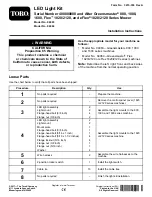
Figure 42
1.
Mounting Tube
2.
Bushing
5. Grease the inside and outside of the new bushings.
Use a hammer and flat plate to carefully drive the
bushings into the pivot tubes.
6. Inspect the caster wheel fork for wear and replace
if necessary (Figure 41).
7. Slide the caster wheel fork through the bushings in
the mounting tube. Replace the spacer(s) onto the
fork and secure with the retaining ring (Figure 41).
Important:
The inside diameter of the bushings
may collapse slightly when installed. If the
caster wheel fork does not slide into the new
bushings, ream both bushings to an inside
diameter of 1.126 inch (29 mm).
8. Grease the fitting on the carrier frame pivot tubes
using No. 2 general purpose lithium base or
molybdenum base grease.
Servicing the Caster Wheel
and Bearings
The caster wheels rotate on a roller bearing supported by
a spanner bushing. If the bearing is kept well lubricated,
wear will be minimal. Failure to keep the bearing well
lubricated will cause rapid wear. A wobbly caster wheel
usually indicates a worn bearing.
1. Remove the locknut and wheel bolt holding the
caster wheel to the caster fork (Figure 43).
Figure 43
1.
Locknut
4.
Spanner Bushing
2.
Cap
5.
Wheel
3.
Roller Bearing
6.
Bushing
2. Remove one bushing, then pull the spanner bushing
and roller bearing out of the wheel hub (Figure 43).
3. Remove the other bushing from the wheel hub
and clean any grease and dirt from the wheel hub
(Figure 43).
4. Inspect the roller bearing, bushings, spanner bushing
and inside of the wheel hub for wear. Replace any
defective or worn parts (Figure 43).
5. To assemble, place one bushing into the wheel hub.
Grease the roller bearing and spanner bushing and
slide them into the wheel hub. Place the second
bushing into the wheel hub (Figure 43).
6. Install the caster wheel into the caster fork and
secure with the wheel bolt and locknut. Tighten the
locknut until the spanner bushing bottoms against
the inside of the caster forks (Figure 43).
7. Grease the fitting on the caster wheel.
Adjusting the Electric Clutch
Service Interval:
Every 100 hours
The clutch is adjustable to ensure proper engagement
and proper braking.
1. Insert a 0.015–0.021 inch (0.381–0.533 mm) feeler
gauge through one inspection slot in the side of the
assembly. Make sure it is between the armature and
the rotor friction surfaces.
2. Tighten the lock nuts until there is slight binding on
the feeler gauge but it can be moved easily within the
air gap (Figure 44).
32
Summary of Contents for 39094
Page 7: ...Slope Chart 7 ...
Page 48: ...Schematics Electrical Schematic Rev A 48 ...
Page 49: ...Notes 49 ...
Page 50: ...Notes 50 ...
Page 51: ...Notes 51 ...
















































